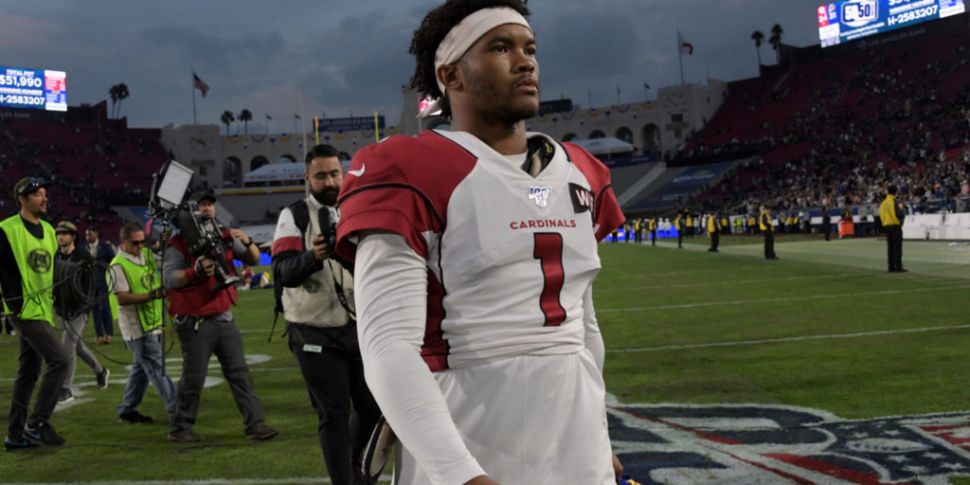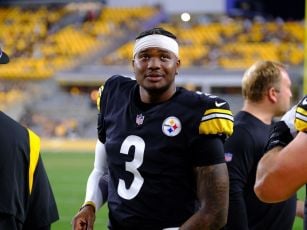The NFL is in the midst of a quarterback revolution. Black quarterbacks—who have historically been prevented from playing quarterback at the highest level in America—are taking over the league. Kyler Murray of the Arizona Cardinals is next.
Kyler Murray broke a trend during the 2019 NFL Draft. Muray became the only sub- 6'0" prospect of the last 20 years to be the first quarterback off the board. NFL teams have historically overvalued size at the quarterback position. Murray is 5'10" and black. Two things that have historically prevented players from playing quarterback in the NFL.
Furthermore, when the Cardinals selected him with the first-overall pick, they still had Josh Rosen on their roster. Rosen was the 10th-overall pick in the 2018 draft.
Teams give up on first-round quarterbacks after one season about as often as they draft 5'10", black quarterbacks with the first pick in the draft. The Cardinals not only did that, but they also fired head coach Steve Wilks after one season to replace him with Kliff Kingsbury, a failed college football head coach. It was one of the most against-the-grain offseasons any team has had.
Kingsbury's value remains undefined. Murray's doesn't.
During his rookie season, Murray proved that he belongs in the NFL. Unlike Rosen, he showed immediately that he has the physical tools to be one of the best quarterbacks in the league. He matched those physical tools with controlled ball placement and outstanding technical precision. He can make plays inside the pocket and outside the pocket. He'll cover for his teammates' mistakes while executing plays as designed and he'll extend plays past their design to create big plays where none otherwise existed.
Murray was the Cardinals' reward for being the worst team in the league in 2018. They only won two extra games in 2019 but Murray will allow them to become playoff contenders in 2020.
As a rookie, he ranked 12th in the league in depth-adjusted accuracy. He was an average short passer, a bad intermediate passer and a great deep-ball passer. Despite his slight frame, Murray has a huge arm. He generates velocity with ease. He combines that huge arm with a quick throwing motion so the ball rockets out of his hand. Importantly, he has control over his arm talent. His excess strength doesn't lead to recklessness like it so often does for NFL quarterbacks.
Writing about the league's next star today. pic.twitter.com/lHHTsYpWSM
— Cian (@Cianaf) July 23, 2020
Murray was more accurate than any recent rookie quarterbacks. He was the only quarterback in the league to compete with Russell Wilson on shot plays.
Wilson is the obvious comparison for Murray. The Seattle Seahawks quarterback has become one of the best quarterbacks in the league over the course of his career. He's short with a huge arm too. He's also a plus-athlete, showing an ability to produce as a scrambler and extend passing plays behind a leaky offensive line. They both understand how to take care of the ball and play with a conservative mindset while still generating big plays.
But Murray is starting from a better place than Wilson did. Wilson developed over his rookie season. His breakout year came in his second season. He was still establishing himself as a worthwhile starter midway through his second season.
Wilson has also always been limited to specific schemes. When the Seahawks have tried to open the offence up into more pass-oriented, spread systems, Wilson's performances became more erratic.
Although David Johnson's name value still carries weight, he hasn't been a Marshawn Lynch calibre running back for a long time. Wilson had Lynch to rely on early in his career. That's not the way the Cardinals offence was built. Murray was carrying this group from day one. Sure, 105 of his passes were screens and he gained more yards on screens than any other quarterback, but they weren't particularly efficient as his crutch to lean on.
Rookies are always inconsistent. It's a matter of seeing enough to anticipate what they become moving forward. Murray showed more than enough to suggest he's going to be a well-rounded pocket passer.
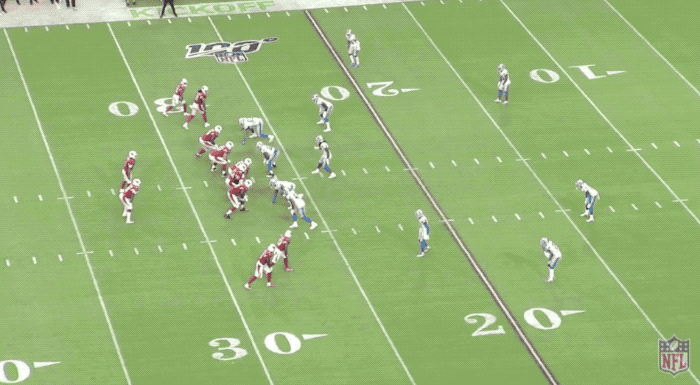
Murray's debut was a struggle. The occasion overwhelmed him. He missed throws he would go on to make routinely and he panicked more in that game than he did at any other point all season. He didn't settle until the fourth quarter. That is when he threw this touchdown pass to David Johnson.
The Lions are playing two deep safeties. They split the field in half and are drawn outside by the wide receivers. Murray lets the play develop so both safeties are clear of the middle of the field. He knows Johnson is running directly down the middle of the field so he's drawing coverage from a linebacker. That's a mismatch.
Having to hold the ball invites pressure.
A benefit of Murray's skill set in the pocket is his lightning-quick release. On this play, the pressure comes around the edge. The left-side defensive end works around the right tackle, putting him in position to knock the ball out of Murray's hand during his throwing motion. He's attacking the ball from a blindspot. The speed of Murray's release and the subtle step forward that the quarterback takes as he releases the ball allows the pass to come out clean.
Importantly, Murray's ball is thrown high and outside. It's not a perfect pass but it's a ball that prevents the linebacker from factoring into the point of the catch. This is a reflection of how Murray throws the ball.
He's an extremely intelligent passer. He understands the leverage of the routes he's throwing to relative to the space available and the coverage he's throwing into. That means when the defender is trailing underneath and inside, he'll purposely place the ball high and to the outside.

This throw against the Tampa Bay Buccaneers from Week 10 perfectly captures how Murray sees openings and understands spacing. He has a receiver running down the sideline. The cornerback let the receiver go to sit in a zone underneath but the safety behind him is covering across. Murray sees both the cornerback and the safety, that's crucial because the defence is trying to bait him into an interception.
If Murray throws this ball to his receiver and leads him forward, the ball will either be intercepted or the receiver will be blown up at the catch point. Instead, Murray purposely throws the ball to his back hip. He sees the underneath cornerback sink, opening the opportunity for him to use the throwing lane to his receiver's back hip.
The ball placement forces the receiver to sit down and turn away from the safety, allowing him to protect himself and secure the catch uncontested.
Murray had bigger throws in that game. A 33-yard touchdown to Kirk showed off his deep ball accuracy. A 69-yard touchdown to Kirk showed off his patience, awareness and deep ball accuracy. Those deep vertical shots are a constant threat to defences. They amplify his effectiveness on the field but his timing throws such as the one above will matter more in terms of sustaining success and executing the offence as designed.
Having such insane arm talent makes it easier for Murray to complete passes 40+ yards downfield. It also allows him to hit tighter windows on shorter throws.
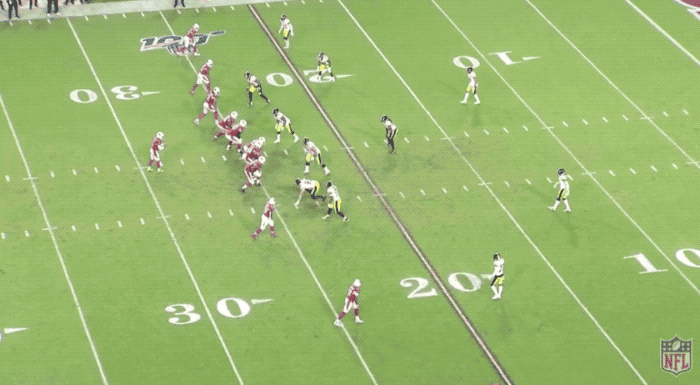
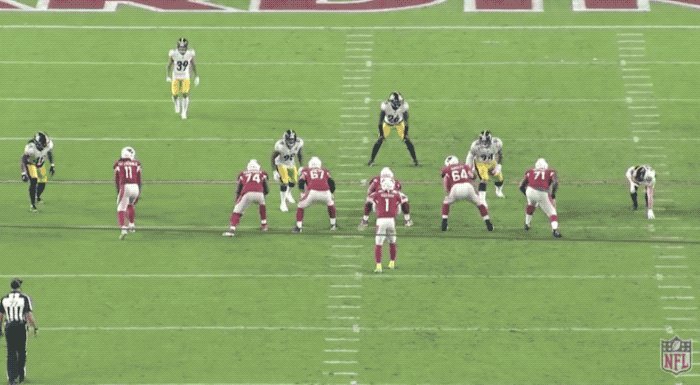
This touchdown against the Pittsburgh Steelers is an impossible throw for 95% of the quarterbacks in the NFL. Murray is on the far hash throwing outside the numbers to the opposite side of the field. The coverage is the same as the previous play, the cornerback sits underneath and the deep safety runs across. This time the safety is in even better coverage.
Because of where Murray is throwing the ball from and the point of the play he releases the ball, the safety is in position to intercept the pass. This, in theory, is a bad decision. Murray's arm talent and accuracy makes it a good decision.
He's capable of pushing the ball past the safety to turn an interception into a touchdown. This was one of the best plays any quarterback made last season.
When you're one of the best deep-ball passers in the league and you make throws such as this one into the intermediate range, it's easy to look past Murray's 27th-overall accuracy in the intermediate range from his rookie season. Especially when you also consider he threw the third-fewest rate of passes into that range.
Intermediate passes are typically the toughest to throw when you have a limited receiving corps. They need to win in their routes and make the right adjustments to hit the right windows.
In Murray's rookie season he had a past-his-prime Larry Fitzgerald, an effective-but-unspectacular Christian Kirk and a good stable of running backs. In his second season, he'll have one of the best receivers in the league, DeAndre Hopkins, which moves Fitzgerald to a better-suited complementary/slot role and will create easier matchups for Kirk. Suddenly, with one big addition, the balance has shifted for the Cardinals offence.
Murray's intermediate passes will be easier this year than they were last year. The trade-off for the Cardinals is that they didn't upgrade their offensive line. They'll need Murray to elevate that line this year. He did that last year but, since he was a rookie, he still took sacks and was baited into mistakes by more advanced defences.
His development in that area is starting from a good base.
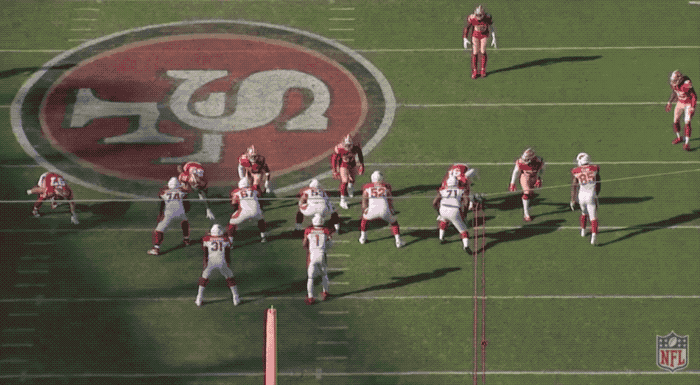
This is a Third-and-7 play against the San Francisco 49ers in Week 11. Muray lets his receivers clear space over the middle of the field before he hits Christian Kirk in stride. Kirk drops the ball but it was a perfect throw. Murray had to hold the ball in the pocket to allow that route to develop. That gave the pass rush time to get home, meaning Murray knew he was taking a hit as soon as the ball came out.
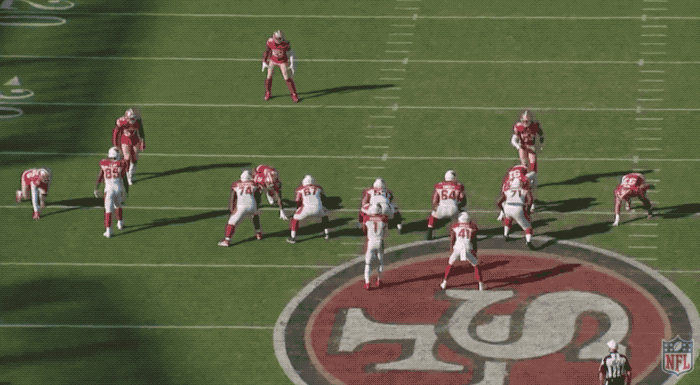
From the same quarter of the same game on a Third-and-11, Muray relocates in the pocket to buy a moment before releasing the ball under heavy pressure into a tight window. That's a spectacular play.

On this play against the Cleveland Browns, he avoids a certain sack to create a big play.
Murray is already beating blitzes and manipulating defenders in coverage to create first downs. His athleticism and arm strength allow him to create wider margins for error and create big plays where they otherwise don't exist. His intelligence and poise will allow him to be an effective pocket passer. Russell Wilson, for all his success, has struggled to see the field consistently over the course of his career and he's rarely created openings by manipulating defenders in coverage.
Those are small weaknesses in an overall great player. Murray's potential is to have those same strengths but without the technical inconsistencies.
He's not on Lamar Jackson's level within the pocket and the Cardinals aren't as good of a team entering this season as the Ravens were entering last season so don't expect Murray to be this year what Jackson was last year. He doesn't need to be that to become a great quarterback though. He probably won't join Jackson and Patrick Mahomes as the best quarterbacks in the league, he'll probably slot into that tier right behind them.
Read Off The Ball's quarterback breakdowns:
Aaron Rodgers is still an elite quarterback.
Baker Mayfield will be a liability again in 2020.
Ryan Tannehill's success is unsustainable.
Deshaun Watson is on the precipice of greatness.
Drew Lock is worthy of his hype.
Jared Goff is still trying to figure it out.
Steelers missed opportunity with Ben Roethlisberger.
New England Patriots, Cam Newton perfect for each other.
Cincinnati Bengals set up well with Joe Burrow.
Patrick Mahomes' success manifests itself in moments.
Download the brand new OffTheBall App in the Play Store & App Store right now! We've got you covered!
Subscribe to OffTheBall's YouTube channel for more videos, like us on Facebook or follow us on Twitter for the latest sporting news and content.

